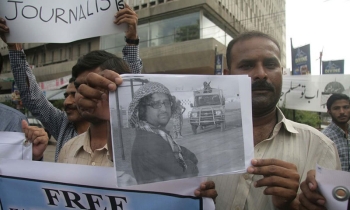Linda Greenhouse got it right, I thought. In an interview in May about the Jayson Blair disaster that was quoted in The Wall Street Journal on June 6, the day after Howell Raines resigned as executive editor of The New York Times, she observed:
"There is an endemic cultural issue at the Times that is not a Howell creation, although it plays into his vulnerabilities as a manager, which is a top-down hierarchical structure. And it's a culture where speaking truth to power has never been particularly welcomed."
Greenhouse, who won a 1998 Pulitzer Prize for her Supreme Court coverage, started at the Times as a clerk in 1968, so she has seen of lot of its comings and goings and ups and downs. She was describing a phenomenon that seemed increasingly true to me, too, in my quarter-century on West Forty-third Street. Making it easier to speak truth to power is surely something the Times leadership must be thinking about.
The top of the structure when I arrived at the Times as a foreign-desk copy editor in 1966 consisted, at least in the masthead hierarchy, of Turner Catledge, executive editor, and Clifton Daniel, managing editor. They were largely hands-off managers. So were some of the department heads, with the notable exception of A.M. Rosenthal, whose Pulitzer-capped career as a correspondent had recently brought him back to New York and the metropolitan editor's job.
The bullpen was a guardian of Times standards – not only for the language, but for greater virtues like fairness and accuracyBut in 1966 the editing process – and therefore much of the day-to-day responsibility for New York Times journalism – was still dominated by Theodore M. Bernstein, an assistant managing editor and an authority on the language, and his top assistant, Lewis Jordan.
Along with three other middle-aged career editors they were the news desk, informally the "bullpen." Organizationally an arm of the executive editor's office, the bullpen had no staff of its own, no departmental turf to protect, and no constituency but the reader. Looking back, I marvel at its autonomy. It was a guardian of Times standards – not only for the language, but for greater virtues like fairness and accuracy. If the culture of responsible journalism had an institutional center at the Times, it was the bullpen. Other papers, later, had ombudsmen to take their publications to task after the fact. The bullpen's work at its best was preemptive integrity.
And the Times in 1966 was an editor's paper. Great power flowed from Bernstein's bullpen to the career editors, "working editors" as I've always thought of them. They were the departmental assistants – and at the foundation, copy editors – who actually put ballpoint pen to reporters' copy or had built their careers on that foundation. Editors ruled.
The upside was that the system did maintain rigorous standards, but even some editors complained that everything seemed to be poured into the same flat mold. Bad writing, of which there was a surprising amount, was made presentable, but really good, original stuff might or might not survive. (Gordon Havens, a copy editor whose longevity at the paper in 1966 matched Bernstein's forty-one years, swore some editor had once encountered "George Washington" in copy and added "the country's first president.")
Worse than silly gaffes – fatally worse – was the arrogant secrecy of much of the editing. Reporters, even the metro people working in the same room, commonly had no idea what editors were doing to their copy until they saw it in the paper the next day. Collegial consultation was far from the norm.
After 1969, when Abe Rosenthal took charge of the newsroom – still almost lily-white and almost all male – change of all kinds came rapidly. Aided by his ever-steadying top deputy, Seymour Topping, and his imaginative, hyper-energetic No. 3, Arthur Gelb, Rosenthal presided over a transformation in the '70s. New sections were added to attract new readers, and saved the paper financially. The staff grew apace, and a lot of old hands yielded to younger people who were comfortable (in varying degrees) with the Rosenthal program. (One of those was a brainy, cocksure young editor named Allan M. Siegal, who in mid-decade showed the Times the way from typewriters and pens to computers.) Women showed up in the newsroom in impressive numbers in those years, and gradually blacks and Hispanics were better represented. Both the women and the minorities sued the paper in the '70s and won settlements promising a better shake. Lawsuits aside, an awakened management's commitment to affirmative action always seemed to me genuine, though uneven.
A lot of people have used the word "genius" to describe Rosenthal, and maybe it's the right word. The New York Times became a much more interesting, varied, readable paper in his era. But the power he wielded was not always easy to speak the truth to, and "top-down" leadership became the Times's style. Meanwhile, a powerful premium attached to capital-W Writing. The pendulum was swinging from editor's paper to reporter's and writer's paper.
In 1974, after a happy but brief tour as a reporter, I returned to editing as an assistant on the national desk. The Nixon presidency was disintegrating; it was a hell of a time to be editing national news. I headed national's night "backfield," charged with pre-editing stories before they went to the copy desk. One afternoon in that tense time, a copy kid dropped a piece of paper on my desk. A duplicate went to Lew Jordan, news editor and head of the bullpen since Bernstein's semi-retirement a few years before. The copy was the first page of the end-stage-Watergate story that would lead the paper the next day.
Almost instantly, it seemed, Jordan was at my desk. The lead of the story read well, he said, but was loaded against Nixon and would have to be redone. We talked about some possible rephrasing.
I called the desk editor in Washington to give him the bad news. About five minutes later he called back to say that if we insisted on the changes, the reporter – one of our best in every way, including his sense of fairness – wanted his byline removed. I told Jordan, who sighed briefly but said, "All right, take it off."
That episode has long seemed to me symbolic – of the happy midpoint of the Times pendulum's swing from editor's to reporter/writer's paper, and of a proper balance between career-editor domination and masthead-down leadership. Jordan the "working editor" could make the decision he did about the principal story of the day without consulting the top brass, and I could carry it out without consulting my own higher authority (though I should have). What neither Jordan nor I could have done was keep the reporter in the dark, as we might have a decade earlier. Abe Rosenthal and the people who reported to him would not allow it. And of course they were right.
But it's also true, I'm morally certain, that within a couple of years no editor below the masthead level – not the news editor, not the national editor, in whose jurisdiction the story was handled – could have made the decision on his own that Jordan made that day. The pendulum would swing too far for that.
Jordan retired a couple of years later, and after a brief interim Al Siegal became news editor and my boss; I had been appointed to the news desk in 1975. It seemed clear to me that under Rosenthal the news editor – and certainly his small cadre of assistants – were expected to avoid involvement in important issues in the day's report. Power was centered higher up.
Siegal became an assistant managing editor – a title Rosenthal never bestowed on Lew Jordan – almost the minute Max Frankel succeeded to the executive editor's job in 1986. Another career editor was appointed news editor, with me as deputy. Frankel, though of the writerly school himself, also found merit in working editors. And he was a much more approachable and much less tempestuous man than Rosenthal.
But Frankel was also more efficient as an administrator, and nothing was too minute for his attention. Top-down control, which he said he opposed in principle, became even tighter. Working editors still referred to the masthead folks as "the grownups." They were mocking themselves for their own ineffectuality, and they were mocking the system that imposed it.
I left the Times in 1991, when Frankel was still editor. Al Siegal was my boss to the end, and I've never had a more able one, or a tougher. He remains a friend. He was named in May to head a post-Blair committee that is reexamining all things Timesian, and I wished him well. We have not discussed the substance of his new assignment. I have been thinking about his task, though, and about some of the questions that the Times might well be asking itself now.
To me the Blair episode is a freak of nature, enormously embarrassing and even damaging to the Times and journalism at large but an aberration, not a sign of basic institutional weakness. Yet aberrations do occur. I find myself asking whether the editor's paper of Bernstein and Jordan would have prevented the Blair mess. It's conceivable that with his error rate and with the power they wielded they'd have raised enough hell to get him fired – or far out of harm's way – before anyone knew he was a thoroughgoing, disturbed con artist. Maybe even before he became one. Blair clearly was cut some slack before his larcenous nature was known – but not after, as far as I can tell – because he was black. It would be a huge mistake to forget that black, white, or green, he was also cut some slack because he could write.
Beyond aberrations of the Blair sort are journalistic excesses with far greater consequences for the body politic. Think Wen Ho Lee. Think Travelgate and Filegate and, for my money, think Whitewater itself, and all the frenzied energy the American press expended on them. Those kinds of excesses, too, also happen when truth can't speak forcefully enough to power.
From all I've read, and heard from Times friends, such speaking was harder than ever there under Howell Raines. But I hope the Siegal committee and the publisher and the next editor will conclude that the problem is not solely a function of personality, and that the structure of the newsroom has put too much power at the top. And that it may be time to swing back the pendulum, creating some entity that has no turf to protect beyond standards and credibility.
It can't be the working-editor autocracy of the past, and I can't offer a detailed prescription. But some such systemic change – some sort of editor-reporter collegium? – should be a serious consideration. An ombudsman is nice for addressing problems after they occur; an agency for preemptive integrity is better.









